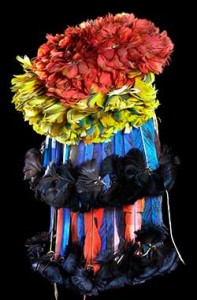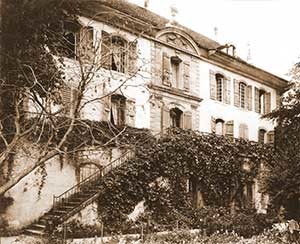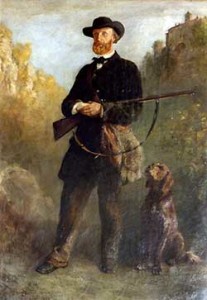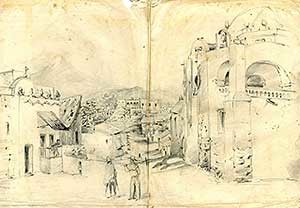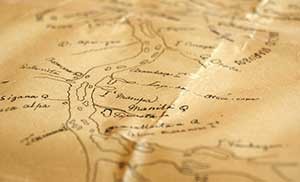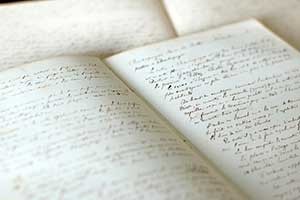While Henri was focused on scientific concerns, he could not resist commenting on the social environment of his new surroundings as well. “To sum it up, with Americans, the head leads and trumps the heart. It is the head that dictates their laws and instructs them on their behavior. This industrial spirit transforms the society by reducing all relationships between men to usefulness. There are noble passions that enrich the soul, money spoils and withers it. It seems that greed is blowing a harmful wind upon America, which, focusing on what is moral within man, cuts down genius, smothers enthusiasm, perhaps down to the bottom of the heart, in order to dry the source of noble inspiration and generous impulses.”
Henri continued on through the U.S. for months, by stagecoach, steamer, and train. After leaving New York, he ventured west, first to Columbus, Ohio. He continued to St. Louis and spent a number of weeks in the Swiss settlement of Highland, Illinois. After Highland he came east again to visit Philadelphia, then traveled southward by train to Baltimore, Washington, D.C., Charleston, and Atlanta before ending up in New Orleans.
He left the United States by steamer from Mobile, heading for Havana. The lengthiest part of his journal is dedicated to his voyage across the Andes and down the Amazon (fig. 6) with the first German settlers to Peru. At the end of his journey in the Amazon basin he bartered with the Mundurucú people and secured the feathered headdress that I saw for the first time 160 years later in a world far away.
Like Henri’s adventure, my project concerning him has continued to evolve. When I found the original journal (fig. 7), my fascination with it took me in its grasp and refused to let go. Beyond the intellectual calculations of its historical value, there was a deeply emotional component. The journal felt viscerally part of me, a creative product that called to me, desiring to be expressed. Publishing the journal was my first thought, but I also thought of a documentary film, retracing Henri’s route in the present day, and perhaps ultimately even a feature film. (As I have never made a documentary, many around me have considered me, well, crazy. Yet the project of Henri’s descendant retracing his route felt like a great story, and still does.)
The most exciting discoveries with the journal came early on. Once I realized that Henri’s voyage had been ignored by his descendants, I felt I could write a new chapter in my family history. It also helped that as a man of the Americas and a French speaker, I found Henri’s writings not only of great interest but also accessible. There have been times when I felt that these words were left for me. A great many other family documents—far older than Henri’s journals and written in German—had been deciphered by others. If Henri had written his journals in German, I might never have realized their value.
Following Henri’s footsteps, I have ventured twice to Switzerland, have introduced my project to many in Mexico and Brazil and most recently made a pilgrimage to Harvard University, Henri’s first stop in the U.S. My most successful trip to Switzerland involved a stop at the ethnological museum in Neuchâtel, where I found the headdress. I also spent some time at the Natural History Museum, co-founded by Henri’s father, where the director commented matter-of-factly, “Well, we do have a monkey.” Taken aback, I inquired what he meant. He took me into a room full of taxidermy animals and showed a capuchin monkey that Henri had brought back from Brazil and donated to the museum.
My time researching Henri’s life and journals is a metaphor for the voyage itself. In the past six years I have slowly embraced his adventurous spirit and it has allowed me to redefine how I see myself. As I followed him down the Continent, I simultaneously went deeper into myself and found out what I really wanted from this life. I still intend to retrace his physical journey, but my explorations through his words have been no less meaningful.
Certain passages are windows into Henri’s soul, offering indications of the kind of man he would become later in life. During his travels, he was deeply moved by orphan homes, and by deaf and blind schools in Philadelphia. He called Girard College (founded in 1833 as a school for poor, fatherless boys), “the most beautiful building ever erected in the name of charity.” And after attending a concert given by blind musicians, he remarked, “I have very rarely listened to music that touched me that much.” In such passages, I see a man who cared deeply for innocence, and children in particular, and with the advent of hindsight, his passages almost seem predictive. Seven years after his return from South America, Henri would marry and become a father. Three of his eight children would be deaf and mute from birth. In order to move his family to Geneva, closer to services for his deaf children, he sold the family’s ancestral castle in 1888.
I sadly do not have personal journals for Henri’s later life, only anecdotes of those who knew him. One passage comes from Adèle de Rougemont, daughter of Frédéric de Rougemont, a contemporary of Henri’s father and author of over 50 books on geography, ethnography, and theology. She wrote to Natalie de Freudenreich, Henri’s fiancée, shortly after their engagement in 1860. “That the most gracious God blesses you abundantly, and allows you to do all the good that you wish around the ancient manor. It’s true the times of the troubadours have passed. No passing minstrel will immortalize a song of love to you beneath its windows. Hopefully in exchange however, you will hear the joyous voices of poor children, who will celebrate the goodness of their young lady of the manor. The de Bürens of Vaumarcus are well known in the area for their generosity towards the poor and Mr de Büren was very wise to choose you to become a partner in his charitable works. He could not have found a more compatible mate in caring about orphaned children or the miseries endured by the sick.”
As he aged, Henri moderated many of his more strident positions and became more open. It must also be noted that he never saw his deaf children as handicapped, and only wanted the best for them. Beautiful art from his daughter Jeanne remains, as well as a boyhood journal from Albert Gustave, Henri’s second deaf child. When the children were young they had tutors at the castle and their life seemed idyllic, reveling in the beauty of everyday life, as Gustave’s small quote portrays: “We were very happy to find small flowers in the fields today announcing the start of Spring. Yesterday we saw butterflies who had left their chrysalis and flew happily on the breeze. As the weather warms, more insects and flowers show themselves, God is bringing them back to life.” Henri made posthumous donations to the School for the Deaf in Geneva, and wanted advantages for his children. His three deaf children represented Switzerland at the International Congress of the Deaf and Mute at the 1900 Universal Exposition in Paris, which spoke interestingly about the U.S. and the great achievements of Thomas H. Gallaudet.
Along the way, I have learned important lessons about Henri and about myself, traits that we share and ways in which we are vastly different, similarities that elicited pride and others that led to self-examination. Henri was a man of his time for good and ill. He cared very deeply for his family, as an early passage written from New York demonstrates: “I think of you and the family often, what you are doing, what you are thinking, and how I would like you to share in my adventure. I feel that your thoughts are with me, they give me strength and confidence to participate in all the new sensations and experiences that the new world has to offer.” He did not like to see animals suffer and yet he was also a hunter. He was a great lover of nature and agriculture, but openly characterized indigenous farmers in South America as lazy for not aggressively exploiting their land. He was a cultural snob, a classist, and most painfully to me, a racist, as seen in his assertion that blacks could not “get by without the help of whites.”
Passages demonstrating racial and social prejudice made me shift in my chair as I read them—it would have been more convenient for me if Henri had been a Swiss abolitionist. While I vehemently disagreed with his prejudices, simply judging him 160 years later would be too easy. Instead I needed to ask myself, why do so many of his passages stir such great emotion in me? I needed to go deeper.
Henri’s views invariably made me re-examine my own. They helped me recognize, in my younger self, my own reliance on judgment. He was quick to judge, quick to dismiss, and was fairly pessimistic about human nature. Wasn’t I just like him at his age? The realization shocked me, and has helped me re-examine how I see the world.
Over time many questions have arisen for me. What is the nature of my inspiration? Why does this project hold such a special resonance for me? How can I honor a family legacy and still be true to my own values? How can I acknowledge Henri’s racism, without tainting the man as a whole? These are questions I would not have thought of asking at the beginning. Something has changed for me. How did I get to a place of seeming uncertainty when my project appeared so clear?
The answer is complicated and it isn’t. The project is about Henri and it isn’t.
As an American, the more I sit with his work, the more I realize that it was never just about Henri. His journey provides a unique glimpse of the pre-Civil War era. One that, through his lens, highlights scientific optimism, celebrates nature, explores social dynamics, and documents racial injustice. His thoughts and observations on the nineteenth century open a larger window into the past, one that shows at times how far we have come and at others how far we still have to go.
This article originally appeared in issue 13.4 (Summer, 2013).

